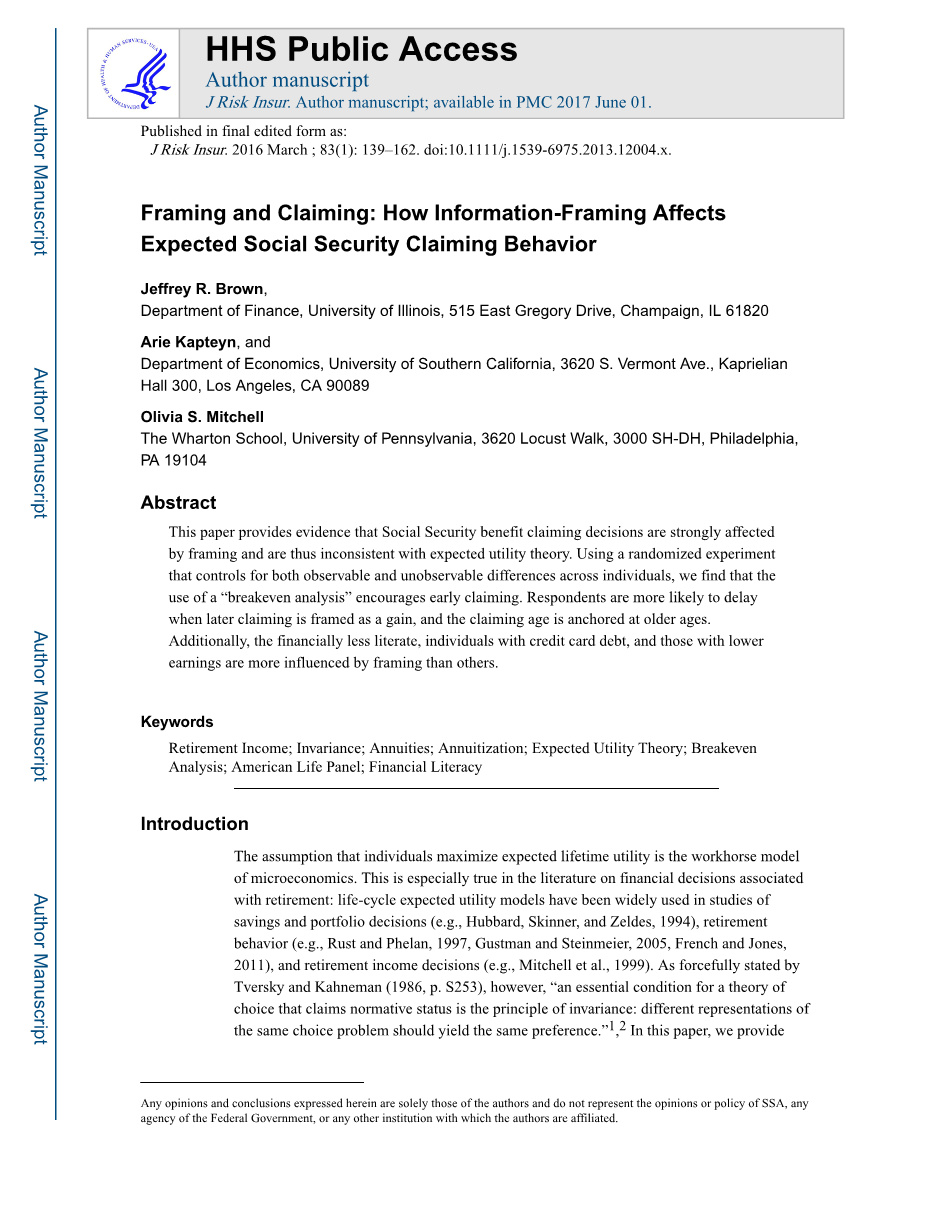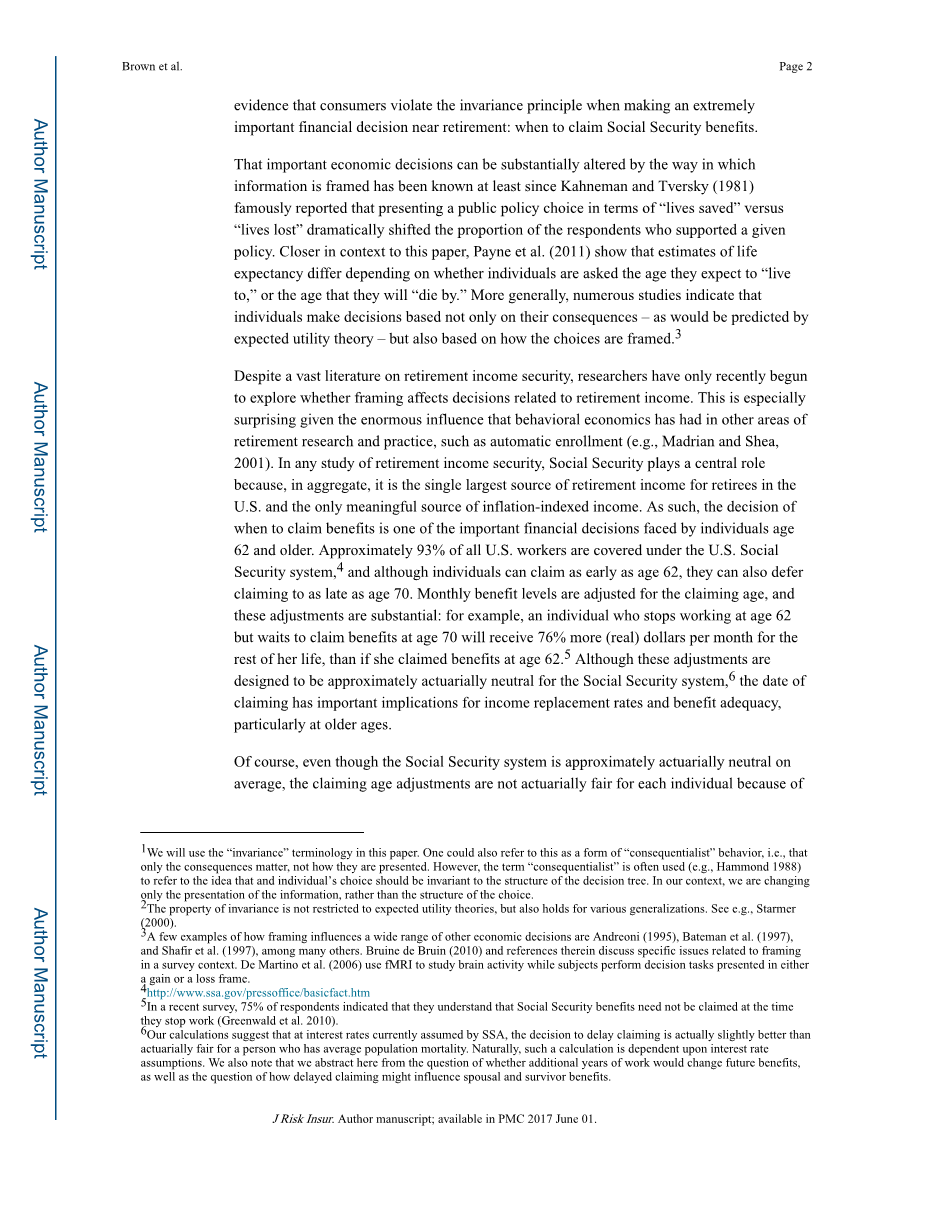

英语原文共 24 页,剩余内容已隐藏,支付完成后下载完整资料
Framing and Claiming: How Information-Framing Affects Expected Social Security Claiming Behavior
Jeffrey R. Brown, Arie Kapteyn, Olivia S. Mitchell
Abstract
This paper provides evidence that Social Security benefit claiming decisions are strongly affected by framing and are thus inconsistent with expected utility theory. Using a randomized experiment that controls for both observable and unobservable differences across individuals, we find that the use of a “breakeven analysis” encourages early claiming. Respondents are more likely to delay when later claiming is framed as a gain, and the claiming age is anchored at older ages. Additionally, the financially less literate, individuals with credit card debt, and those with lower earnings are more influenced by framing than others.
Social Security Benefits and Claiming
A covered worker who has contributed to the U.S. Social Security system for sufficiently long (approximately 10 years) confronts a choice regarding when he can claim his Social Security benefits. Under current law, age 62 (known as the Early Retirement Age) is the earliest that one can claim. The rules also specify a Normal Retirement Age (NRA) at which “full” or unreduced benefits can be paid. The NRA is currently age 66 (for those born 1943–54; under current law it will rise to 67 for people born in 1960 and later).
The SSA computes benefits by averaging a workerrsquo;s highest 35 years of wage-indexed earnings and dividing by 12 to obtain the workerrsquo;s Average Indexed Monthly Earnings (AIME). This AIME is then run through a non-linear formula to compute the workerrsquo;s Primary Insurance Amount (PIA), which is the benchmark amount from which benefits are calculated. If the worker claims benefits at the NRA, his benefit equals 100% of his PIA. If he claims at earlier or later ages, his benefit is actuarially adjusted, and this adjustment continues for the rest of his life. The actuarial adjustments are made to recognize that, on average, early claimants will receive benefits for a longer period than will those who delay claiming. These adjustments therefore seek to be roughly actuarially neutral from the perspective of the government: on average, people who take an earlier, lower benefit would expect to receive about the same total amount in benefits over their lifetimes as those who take the later, higher benefits. The age one stops working need not equal the age at which one claims benefits,although the claiming and retirement ages are highly correlated for a wide range of reasons. We note that if an individual both delays claiming and continues to work, his monthly benefit may rise both because of the actuarial adjustment and because the additional years of earnings may increase his PIA.
The major benefit of our experimental design is that it is simply not necessary for us to know anything about each individualrsquo;s optimal claiming date, optimal retirement date, or the interaction of the two. Randomization and individual fixed effects ensure that we are finding a causal effect of the frames on expected claiming behavior, and evidence that expected claiming ages are sensitive to framing is sufficient to reject invariance and thus expected utility theory.
Although our paper is the most direct and most comprehensive study on the effect of framing on Social Security benefit claiming behavior, there are two unpublished working papers suggesting that framing effects may matter for claiming. Dominitz et al. (2007) documents differences in expected claiming based on how information is presented, although it is not possible to discern whether their results are due to framing effects or to the implicit advice embedded in their presentation (e.g., their frame tells an individual that if he expects to live beyond a particular age, “then it would be to your advantage to delay your retirement.”)In contrast, our frames provide the same underlying information but changes how that information is presented, without telling individuals which decision would be in their interest, thus allowing us to test for a causal effect of the frame as distinct from the provision of advice.
A second working paper which focused broadly on documenting overall knowledge of Social Security program rules also provided suggestive evidence of framing. Liebman and Luttmer (2012) asked survey respondents to choose between claiming at age 62 or age 65 after showing them three frames, and they found that a breakeven presentation reduced the probability of choosing age 65 by 18.5 percentage points. Our paper has several advantages, including that we allow individuals to choose from the full continuum of ages (rather than artificially restricting them to a binary choice between ages 62 and 65): among other things, this allows us to quantify the effect of framing on the average claiming age. We also can control for baseline claiming ages and individual fixed effects, so we can handle unobservable differences across individuals that otherwise might bear results. We also explore a wider range of frames (10 versus 3), examine the effect of multiple frame exposures, and document how sensitivity to framing effects varies with individual characteristics.
Study Design
We used focus groups to qualitatively test our frames,after which we fielded these using survey modules in the RAND American Life Panel (ALP), a sample of U.S. households regularly interviewed over the Internet. An advantage of the ALP relative to most other Internet panels is that it uses a probability sample of the U.S. population to approximate a nationally representative sample.At the time of the study, the panel comprised about 3,000 active panel members. We limited our sample to respondents who had not already claimed a benefit and who had worked at least 10 years (so we could compu
剩余内容已隐藏,支付完成后下载完整资料
资料编号:[469923],资料为PDF文档或Word文档,PDF文档可免费转换为Word


